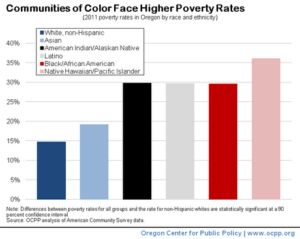Statement by OCPP Policy Analyst Jason Gettel on Census Data Release
Poverty in Oregon increased yet again last year, and poverty levels are particularly alarming among children and communities of color. It is time for Governor Kitzhaber and state lawmakers to develop a plan to reduce poverty.
The U.S. Census Bureau reported that the share of Oregonians living in poverty increased to 17.5 percent in 2011 — up from 15.8 percent in 2010 and 12.9 percent in 2007, prior to the start of the recession.
Child poverty increased as well. Last year 23.6 percent of children in Oregon (almost 1 in 4) lived in poverty. This was up from 21.6 percent in 2010 and 16.9 percent in 2007.

Poverty levels are worse for communities of color compared to non-Hispanic whites. In 2011, the poverty rate for non-Hispanic whites in Oregon was 14.8 percent (1 in 7). By contrast, the poverty rate was 19.2 percent (1 in 5) for Asians, almost 1 in 3 for African Americans (29.7 percent), Native Americans (29.8 percent) and Latinos (29.8 percent), and more than 1 in 3 (36.2 percent) for Native Hawaiian/Pacific Islanders.
The rise in poverty has a direct and immediate cost to Oregon. Last year about 662,000 Oregonians were living in poverty — 66,000 more than the year before. The increase in the total number of people in poverty adds to the demand for public services.
Child poverty, in particular, has long-term, negative consequences for our state. It’s well known that poverty makes it harder for children to thrive in school, and that economic hardship and family instability early in life can lay the groundwork for more costly social problems down the road and undermine efforts to achieve opportunity and prosperity.
Rather than plotting to create new tax breaks for the rich and for profitable corporations, Governor Kitzhaber and the Oregon legislature should devise a plan to confront poverty.
About today’s Census data
Today’s Census Bureau release is based upon the results of the 2011 American Community Survey (ACS). The ACS generates more reliable estimates and comparisons of state-level data than the Current Population Survey released earlier in September.








